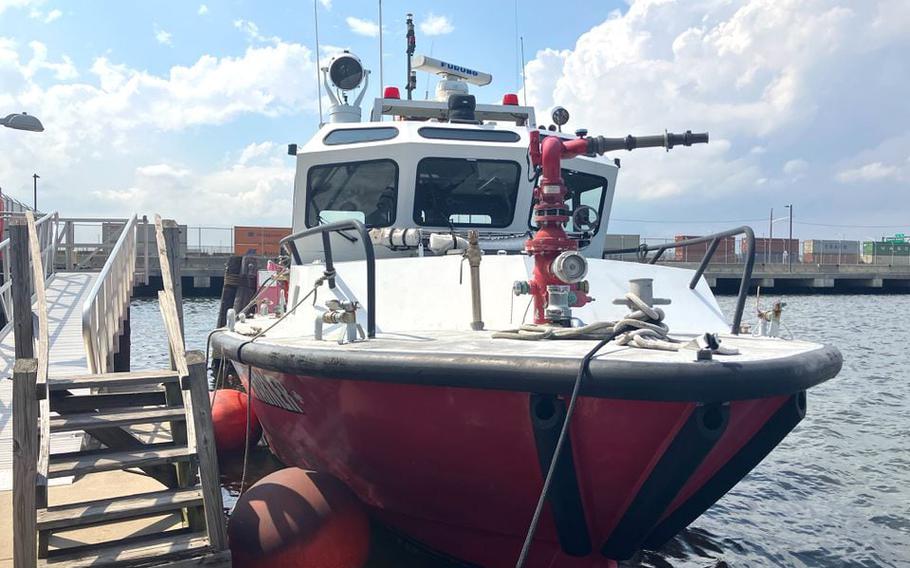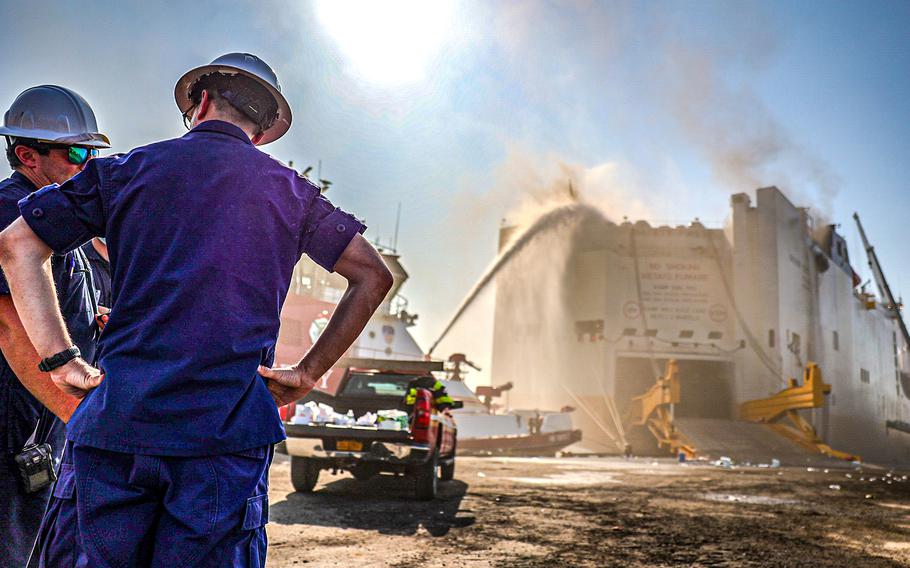
Newark's fireboat did not start on a routine inspection the morning of the Port Newark fire. Witnesses testifying before a Coast Guard hearing said the vessel had been out of service for months because of a lack of maintenance. (Steve Strunsky, nj.com/TNS)
(Tribune News Service) — It wasn’t just one mistake.
Witnesses called to testify in a series of public hearings over the past two weeks by the U.S. Coast Guard in conjunction with the National Transportation Safety Board into the fire that killed two veteran firefighters offered new insights into the problems firefighters faced when they were called to battle a ship fire at the largest port on the East Coast.
Even before a battalion chief made the fateful decision to check out the conditions deep below decks aboard the Grande Costa d’Avorio — an order experts testified should not have been given — there were significant problems with equipment, manpower, and a lack of knowledge about marine firefighting, the hearing officers were told. Those issues, compounded by failures of the ship’s crew as well, led to tragedy as a small fire turned into a big fire on a July night.
Among those who appeared before the inquiry included ranking officers of the Newark Fire Department and its former chief, members of the ship’s crew and its captain, longshoremen who had been loading the 692-foot freighter with more than 1,000 second-hand vehicles when the fire broke out, and experts intended to weave it all together.
Coast Guard Cmdr. Christian Barger, the lead investigator, said the purpose was to “determine what really occurred on July 5,” when veteran firefighters Augusto “Augie” Acabou, 45, and Wayne “Bear” Brooks Jr., 49, died after they became disoriented and trapped on Deck 10 of the ship.
They have yet to reach any conclusions. But their fact-gathering in the public hearings held at the municipal building in Union Township, about 8 miles from Berth 18 at Port Newark where the Grande Costa d’Avorio burned, have brought to light more details about the events of that night.

Coast Guard members discuss response operations to a fire on the motor vessel Grande Costa D’Avorio in Port Newark, N.J., on July 6, 2023. Marine fire fighting specialists are actively conducting fire suppression both from the pier and on the water. (Dan Henry/U.S. Coast Guard)
How did the fire start?
The 16-year-old Jeep Wrangler had been working hard all day.
Modified with a steel push bar on the front, it was being used to shove inoperable cars, SUVs and light trucks up a ramp at the stern of the freighter which was designed to carry wheeled cargo. Gavin Puchinsky, a longshoreman employed by American Maritime Service, was behind the wheel as the Jeep pushed a Toyota Venza up to Deck 10 at about 9 p.m. That’s when he heard a loud clunk, describing the sound like a wrench being dropped to the floor.
“I didn’t pay any attention to it,” he testified. “There was a lot of noise.”
Soon there would be a lot of shouting. Through the open windows of the Jeep, people suddenly started screaming at him to get out. Underneath, he saw what looked like “flaming fireballs dripping from the bottom of the vehicle.”
That was almost certainly the dying moments of a badly overheated transmission, according to Matthew Hartnett, a special agent for the Bureau of Alcohol, Tobacco, Firearms and Explosives. He said the Wrangler had been subject to a past recall by Chrysler over concerns that hot transmission fluid could catch fire on a hot engine or exhaust under severe conditions, such as long usage of its 4-wheel-drive, or trailer towing, which the automaker warned could cause an “under-hood fire without warning.”
Puchinsky’s description of flaming fireballs was almost certainly burning transmission fluid, Hartnett testified.
Members of the ship’s crew tried to put it out with hand-held fire extinguishers. But the flames soon spread.
The broken fireboat
On the night of the Port Newark fire, the city’s $1.1 million fireboat was dead in the water.
Equipped with twin diesel 800-horsepower engines, the 52-foot boat had sonar and thermal imaging to help locate objects under the water. There were two powerful water cannons on the stern and one remote-controlled cannon on the bow that could shoot 3,000 gallons of water per minute.
It had a top speed of 37 knots or about 43 mph. But that morning on a routine inspection, it wasn’t going anywhere. It did not start, testified Battalion Chief James Kupko, who is responsible for Newark’s marine unit.
In fact, other witnesses testifying before the Coast Guard said the boat had been out of service for months.
Francis Gorman, a Coast Guard port security specialist for Sector New York, noted that Newark was part of a regional fireboat task force that included Jersey City, Bayonne and other cities with waterborne firefighting capabilities that provided mutual aid to each other when fighting waterfront fires. In 2022, that task force responded to 112 calls for assistance. Newark did not take any of those calls, he testified.
Public Safety Director Fritz G. Fragé in a statement said the boat was out of service, but added it was “not operationally feasible to deploy a fireboat to the port fire because of the cargo ship’s height and size.”
As the conditions aboard the Grande Costa d’Avorio worsened, the Fire Department of New York sent one of its big Ranger 4200 class fireboats, which are able to throw enormous amounts of water, to the scene to help cool down the hull.
A failure to communicate
The radio problems Newark firefighters had during the fire on board the Grande Costa d’Avorio were well documented before the Coast Guard hearings began.
Interference within the steel hull of the ship cut out transmissions at critical times or garbled calls. At one point, a mayday call for help couldn’t be heard by dispatchers.
“Did you just hear Engine 16′s last transmission?” one firefighter had radioed in. “Be advised it sounded like he said he cannot find his way back out.”
But the problems of communicating during the July 5 fire went beyond the blocking of signals inside the ship compartments.
The system also would “bump” calls, according to Michael Richardson an investigator for the National Institute of Occupational Safety and Health. Two people could not transmit at the same time. If a firefighter inside the vessel was calling for assistance at the same time a dispatcher was speaking, that call would have been blocked.
At the same time, the heavy radio traffic that night only added to the communications problems. At one point after Acabou was found wedged between a small truck and an SUV, those in command mistakenly believed that a call after midnight regarding the recovery of a “downed firefighter” was the then-missing Brooks. In fact, it was an Elizabeth firefighter overcome by conditions during the search for Brooks.
The one firefighter without a radio, the testimony revealed, was Brooks himself.
“His radio was not recovered on the ship,” Richardson told the board. “Newark conducted a search. They cannot locate his radio on the apparatus or the firehouse. It is unaccounted for.”
Putting out the fire
When the fire broke out on Deck 10, the Grande Costa d’Avorio had a way to smother it.
The ship was equipped with a CO2 fire suppression system, typically intended for emergencies while underway at sea. It required closing all watertight doors, evacuating the crew from those spaces, and flooding the compartments below decks with carbon dioxide to starve the fire of oxygen.
But the freighter was in the process of loading vehicles when the fire broke out and it was not so simple to seal the vessel.
Benito LaFauci, the ship’s chief mate, testified that the crew first tried to put out the flames in the Jeep with handheld fire extinguishers. While they briefly knocked it down, it flared up again once the extinguishers were depleted. Then they tried using the ship’s own fire hoses.
Tearfully apologizing for the crew’s failure to the family members of Brooks and Acabou, who attended the proceedings every day, LaFauci said the captain ordered the release of the CO2 and the closing of all watertight doors. But they were unable to shut a large garage-sized door leading to the loading ramp. He tried several times, but told the hearing board: “We could not operate the door.”
Capt. Alessandro Moretti, the ship’s master, triggered the fire suppression system anyway. With the ramp door open and unable to seal off the vessel, though, the CO2 appeared to have little effect.
William Burket Jr., director of the Maritime Incident Response Team with the Virginia Port Authority and an expert on maritime firefighting, said despite the belief that the suppression system had failed, it was the best tool that firefighters had.
“In my opinion the CO2 was effective to a point,” he said, pointing out there was no active fire being seen when firefighters were sent down below. “My advice would be not send anyone in there.”
The fire department should have simply waited it out, Burket said.
How they died
They found Augie Acabou entangled in the lashing straps securing the vehicles on board the Grande Costa d’Avorio.
“Bear” Brooks was found against an interior column, more than 200 feet from the port stairwell, not far from an escape trunk that could have led him to safety had he known it was there.
Both had run out of air. But the Coast Guard brought in a U.S. Navy medical examiner to testify after an autopsy by the New Jersey Medical Examiner’s office suggested that Brooks had suffered blast injuries.
Throughout the hearings, members of the Coast Guard team repeatedly questioned firefighters whether there had been a “backdraft event” on board the ship during the fire. Eyewitness accounts from Jersey City firefighters who were part of the search-and-rescue effort to find Brooks also told of hearing explosions inside, which were believed to be car tires blowing up from the heat.
None of the Newark firefighters who testified, though, believed there had been a backdraft when they entered Deck 10. However, the Coast Guard brought in Navy Cmdr. Bryan Platt, a deputy medical examiner at Dover Air Force Base.
“Blasts are not subtle injuries,” Platt said. But Brooks showed no obvious burns, blunt force trauma or visible pressure injuries other than what he called “micro lacerations” of tissues that did not indicate an injury from an explosion.
“I have no evidence of blast,” he said. As for a backdraft event, he shook his head. “No. Neither had burns.”
Both Brooks and Acabou, he concluded, died from carbon monoxide toxicity resulting from the fire.
What’s next?
Barger said the ending of the public hearings was not a conclusion of the board’s fact finding. There will be additional witnesses questioned, some via livestreamed sessions available to the public.
Once all relevant testimony has been obtained, separate final reports will be issued by the Coast Guard and NTSB.
Fragé, the city’s public safety director, said Newark’s focus is on ensuring that such an event never happens again.
“On July 5, 2023, Newark’s firefighters set out to do their job — nothing more and nothing less. What unfolded was a horrific tragedy that Mayor (Ras) Baraka, Assistant Director (Rufus) Jackson, myself, and our entire public safety family will never get over,” he said. “Our hearts go out to the families of Captain Acabou and Captain Brooks, Jr., whose grief is beyond what we can imagine.”
Ted Sherman may be reached at tsherman@njadvancemedia.com.
©2024 Advance Local Media LLC.
Visit nj.com.
Distributed by Tribune Content Agency, LLC.